Understanding how electric vehicle (EV) batteries are made provides insight into the intricate process behind powering the future of transportation. It begins with the selection and preparation of battery materials, including lithium, cobalt, nickel, and graphite, which are sourced from various regions worldwide and all go into EV battery packaging.
The manufacturing process typically involves several key stages. First, the electrode materials are produced by mixing and coating active materials onto metal foils to create the anode and cathode.
These coated foils are then stacked with separator layers to form the battery cell.
The cells undergo assembly into battery modules, which consist of multiple cells connected in series and parallel configurations to achieve the desired voltage and capacity. This assembly process involves precision welding, stacking, and sealing to ensure the integrity and safety of the battery pack.
Once assembled, the battery modules are integrated into the battery pack, along with additional components such as thermal management systems, control electronics, and casing for protection. This final assembly stage includes rigorous testing and quality assurance to verify performance, durability, and safety standards.
Throughout the manufacturing process, strict quality control measures are implemented to monitor materials, components, and production processes, ensuring consistency and reliability in the final product.
The production of EV batteries involves a complex and highly specialized manufacturing process, drawing on advanced materials, technologies, and expertise to deliver high-performance, long-lasting, and safe battery systems that drive the transition to sustainable transportation.





